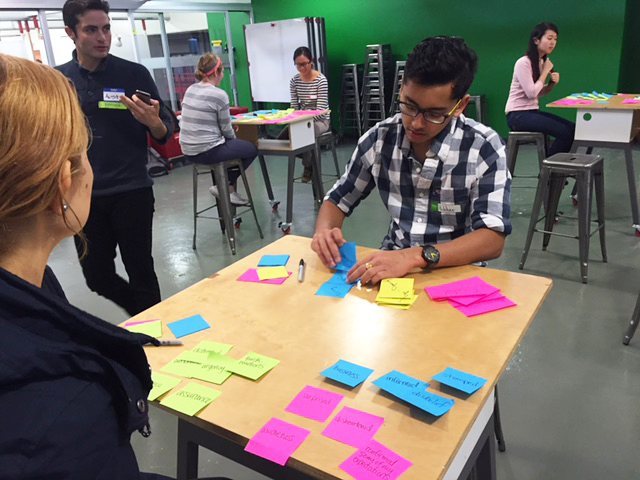This week we are in the “synthesis” phase of the design process. So far, students have interviewed clinicians and newly delivered parents, observed three L&D medical simulations at CAPE , focused on challenges in the physical environment and had a tour of Lucile Packard Children’s Hospital. A lot of information has been absorbed, and now it’s time to digest and synthesize what has been most meaningful for students. For the first phase of synthesis, Henry and I wanted to approach it from an emotional standpoint. What made you feel uncomfortable and why? What disturbed you or made you take a note or draw a sketch o what you saw? What completely surprised you about one of your user interviews?
With that point of view in mind we welcomed Austin Meyer,
co-founder and facilitator at Collective Capital, and Design Thinking Facilitator and Strategist at SAP. Austin started our class off by helping us become more present, and connected to our fellow students in the room. We used an invisible ball which we “threw” around our circle while repeating the person’s name who threw it, and then launching it off towards another person while saying our own name. For some reason this was difficult for me to master! We moved into games such as secretly choosing an “A” & “B” person with whom we had to create an isosceles triangle with while moving around a room, or secretly defend the “A” person from the “B” person while moving around the room, the 1-2-3 game, active listening + add-on to story game, and the fabulous personalized handshake with a partner game.

These games helped us feel a sense of safety with each other, understand that “messing up” should be a shared responsibility (“ta-da!”) and foster a sense of connection with a partner. After this phase we had some time to experience the “creation” phase where we quickly formed “scenes” using our bodies to become anything from a tree, to dirt on the ground, to a picture snapping Stanford tourist. The point of this game was to create something together quickly without over thinking it, while trusting that whatever we came up with would be accepted by the group–a great prelude to brainstorming etiquette! At the end of the class, Austin asked us to write down some words that described our feelings at each of the three “empathy sessions” (interviews, simulations and hospital L&D tour).
For homework, I have asked students to send us one word from each of their experiences that sum up the feeling they had in each empathy-building context. Based on this emotional information as well as student’s written insight homework, Henry and I will develop large need buckets for Thursday’s class (TBD…) and students will gravitate towards the areas they are most passionate about while forming work groups. I’m looking forward to the next class where we will work towards defining problems that are actionable through design.







